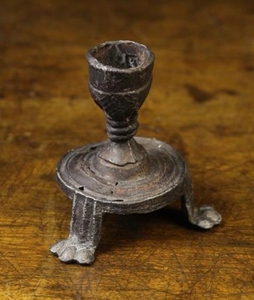Pewter ware was made by melting and pouring into molds, which in the Middle Ages were often plaster or clay reinforced with calf hair. Adding a design was done by chiseling or etching with acid. Stamping a design was not always useful, since the pewter was soft enough that you would need to support it from the other side; the force of the stamp could easily deform the nice round shape of a goblet or tankard. (Stamping a flat plate would work.)
Pewter was turned into anything imaginable for daily use: plates, bowls, mugs, flatware, basins, measuring spoons and cups, ladles, goblets and cups and tankards, candlesticks (see picture for a 14th century example), teapots and sugar bowls and cream jugs. Pewter was so useful and common that regulations cropped up to ensure quality control.
The lead content is a concern, of course, and modern pewter designed for human contact contains no lead. Higher lead content produced darker pewter, so if handling an antique, the darker it is, the less you want it in contact with your skin. Lead toxicity was well-known to the Romans; they recognized that those who worked extensively with lead suffered the same cognitive symptoms. Colonial American higher quality pewter—a well-to-do person's dining room table, for instance—was likely lead-free (substitutes were antimony, brass, copper, or zinc), even though there was plenty of lower quality pewter being made using lead, especially in the kitchen.
Developments in glass-making and pottery, such as the introduction of porcelain—especially when Portuguese traders started bring back kaolin from China, allowing potters to make their own fine white "china"—made pewter less desirable. In the 19t century, however, there was a revived interest in England in medieval styles and art. I first mentioned the man responsible for this interest a decade ago; time to re-visit him ... tomorrow.
